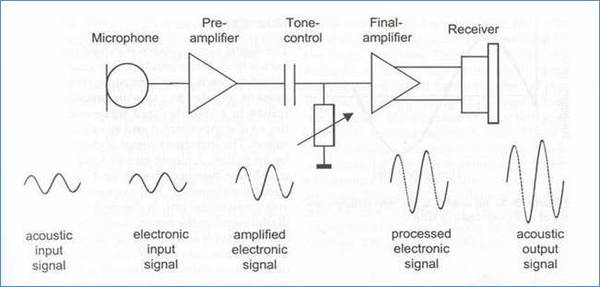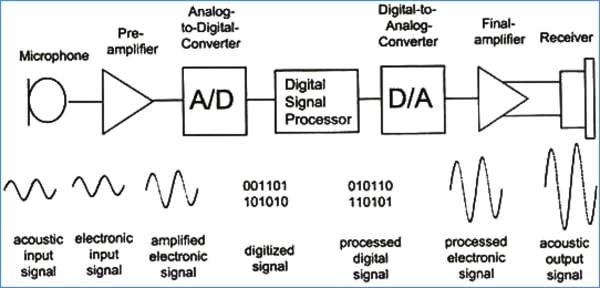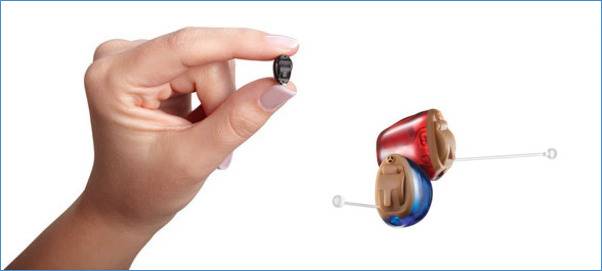Majority of the people buying a new hearing aid have faced this question. The Audiologist offers an option to choose between an Analogue and a Digital Hearing Aid. For a non-technical person, this is very confusing. The main concern of the Hearing aid user is to hear well.
The basic function of all Hearing Aids is the same. That is to amplify and deliver distortion free sound with most clarity. There is a big difference in technology. Buyers should know the difference between Analogue and Digital Hearing aids. Read to know the differences between the 2 technologies.
Electronics circuits have 2 types of speech signal processing system. The Analogue sound processing and Digital sound processing. Research on digital sound processing started in the 1960s at Bell Laboratories. Widex, a Dutch manufacturer marketed the first commercial digital Hearing aid.
Analogue Hearing Aids

Analogue sound processing technology is very old. Transistorized analogue hearing aids were first available in the year 1952 – 53.
Analogue Hearing Aids have 3 basic sections:
1. Microphone
Collects the sound signals or Speech signals.
2. Pre-Amplifier and Amplifier
Amplifies the signal picked up the Microphone.
3. Receiver or Speaker
The part which finally delivers the signal or sound to the human ear.
How the Hearing Aid Works
Hearing Aid Microphone
The Microphone picks up the sound waves and converts them into electrical signals.
Hearing Aid Tone Control
Manufacturers also provide Tone controls. Tone control can change the tonal quality or speech quality. The Tone Control decreases or increases the high frequency and Low frequency. High frequencies are sharp sounds. And Low frequencies are heavy thumping or drum sounds. Tone control helps to match the hearing loss of the user. Analogue hearing aids cannot be precisely tuned to the user’s ear response. The circuitry is also considered a little noisy which reduces the clarity of sound.
Hearing Aid Amplifier
These signals reach the amplifier. As the name suggests, this section amplifies the signal or makes it louder. The amplifier controls the loudness as per the users Hearing loss.
Initially, Analogue Hearing Aids were more affordable than digital Hearing Aids. Presently all reputed Companies have phased out analogue hearing aid technology. Digital hearing aids have become affordable.
Digital Hearing Aids

The Hearing aids presently available use 100% Digital sound processing technology. The basic principle is the same as analogue hearing aids. That is to amplify sound signals with the least noise and distortion. But the technology used is much different and effective.
Hearing Aid Microphone
Like an Analogue hearing aid, the microphone picks up the sound or speech signal. This signal passes on to the Pre-amplifier.
Hearing Aid Analogue to Digital Converter
The signal picked up by the microphone is in the analogue form. The Analogue to Digital converter converts the analogue signal into digital form. It is also called a D to A converter.
Hearing Aid Digital Sound Processor
The digital processor has many circuits working within it. It processes the signal as per the user’s hearing loss. This matches the output of the Hearing aid to the hearing loss as per the Audiogram.
Signal Output
The signal is again converted to the Analogue form. This time a Digital to Analogue converter does the job. The analogue signal is finally amplified and delivered to the user’s ear.
Difference between Analogue and Digital Hearing Aids
Audiologists and Hearing care professionals do not recommend Analogue hearing aids. The advantages in Digital hearing aids are far more than analogue hearing aids.
Advantages of Digital Hearing Aids
Multiple Hearing Programs
Digital Hearing aid processor is like a small computer. The processor is capable of saving the settings made by the Audiologist. The Audiologist can save multiple settings for listening in different situations. Most hearing aids have 3 program settings. Program 1 is generally set for indoor use. Program 2 is set for outdoor use or speech in noise. In this mode, the hearing aid reduces the unwanted surrounding noise. The 3rd program is generally set for listening to the Telephone.
Less Feedback
The Digital circuitry detects the feedback. It is smart enough to differentiate between feedback and regular high pitched sound. The processor cancels the feedback so the user may hear clearly.
Light Weight, Small and Invisible

Due to miniaturisation in electronics the Digital hearing aids have become very small. The hearing aids are invisible to others. In fact, there is a new style of Hearing aids known as Invisible Hearing Aids. Many deaf people do not use hearing aids as they don’t want others to know. The small size has encouraged people to use hearing aids.
Automatic Settings
The advanced digital Hearing aids detect the surrounding noise. The settings are automatically changed. The user hears comfortably irrespective of the surroundings. Most hearing aids have these basic features to help the user.
User-friendly Features
The list of features does not stop at multi-program settings. Bluetooth connectivity, Remote control, Data Logging are some of the useful features. Do read this article on 9 Useful Features in Digital hearing aids.
Personalisation
The pattern of Hearing loss differs from one person to another. Accordingly, every hearing aids programming or tuning is as per the user’s hearing loss. The user can personalise the hearing aid as per the required size, style, fit and programs.
Disadvantages of Digital Hearing Aids
Hearing Aid Prices
The cost of Digital Hearing aids is higher than analogue hearing aids. The benefits justify the higher price.
Disadvantages of Analogue Hearing Aids
- Multiple listening settings feature is not available in the analogue hearing aid.
- Feedback cannot be properly controlled.
- Background noise level cannot be properly controlled
- Analogue hearing aids are small but not as small as Digital hearing aid.
- Sound improvement features are not possible in analogue hearing aids
- Extra features like Bluetooth and Remote control are not possible.
The difference between Analogue and Digital hearing aids favour the Digital Hearing aids. Hearing aid manufacturers spend millions every year in research and development. The aim of the manufacturers is to provide high-quality speech and user comfort. We should encourage the use of digital hearing aids.
